Michael Shavlovsky
Orbit: A Framework for Designing and Evaluating Multi-objective Rankers
Nov 07, 2024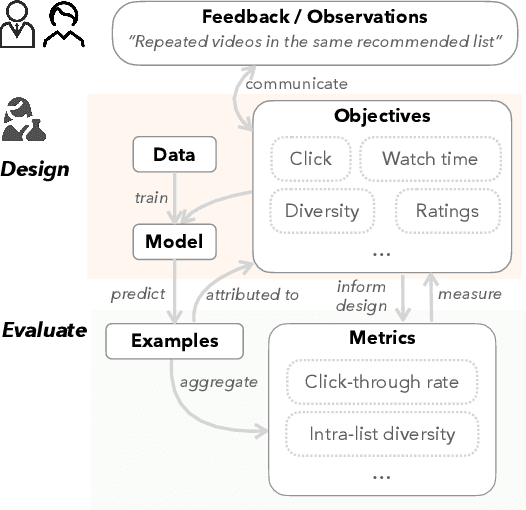
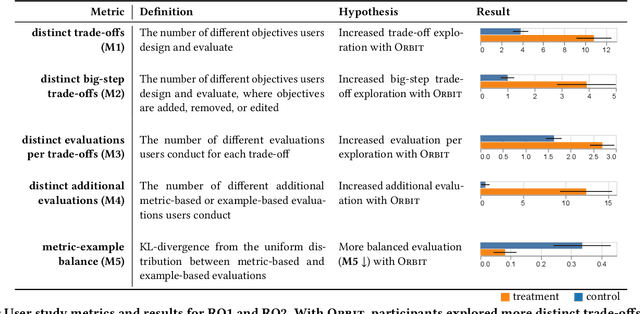
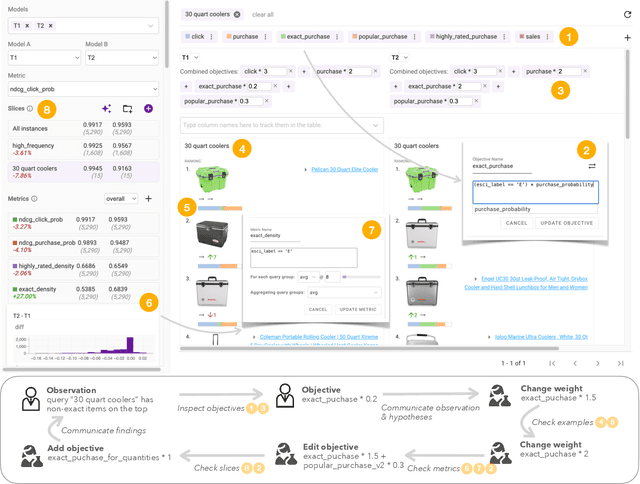

Abstract:Machine learning in production needs to balance multiple objectives: This is particularly evident in ranking or recommendation models, where conflicting objectives such as user engagement, satisfaction, diversity, and novelty must be considered at the same time. However, designing multi-objective rankers is inherently a dynamic wicked problem -- there is no single optimal solution, and the needs evolve over time. Effective design requires collaboration between cross-functional teams and careful analysis of a wide range of information. In this work, we introduce Orbit, a conceptual framework for Objective-centric Ranker Building and Iteration. The framework places objectives at the center of the design process, to serve as boundary objects for communication and guide practitioners for design and evaluation. We implement Orbit as an interactive system, which enables stakeholders to interact with objective spaces directly and supports real-time exploration and evaluation of design trade-offs. We evaluate Orbit through a user study involving twelve industry practitioners, showing that it supports efficient design space exploration, leads to more informed decision-making, and enhances awareness of the inherent trade-offs of multiple objectives. Orbit (1) opens up new opportunities of an objective-centric design process for any multi-objective ML models, as well as (2) sheds light on future designs that push practitioners to go beyond a narrow metric-centric or example-centric mindset.
HyperDPO: Hypernetwork-based Multi-Objective Fine-Tuning Framework
Oct 10, 2024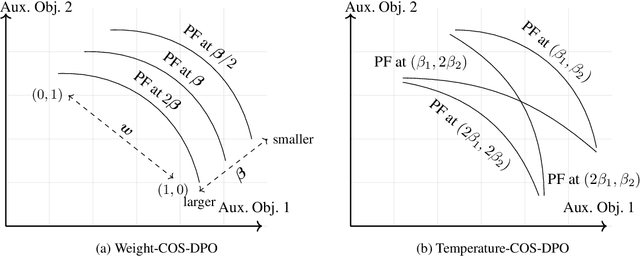
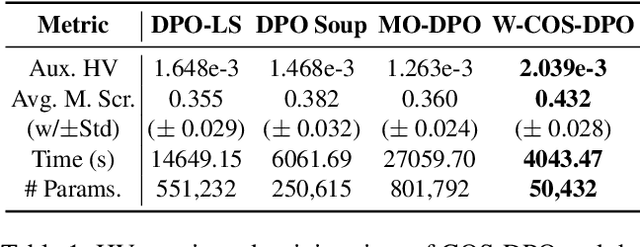
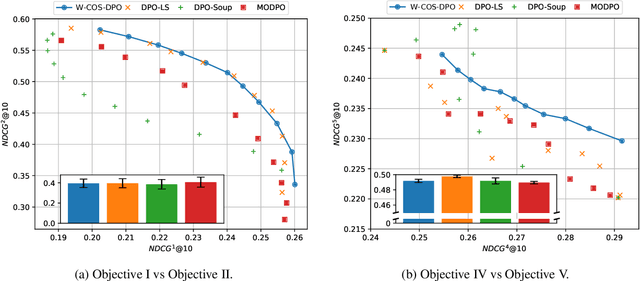
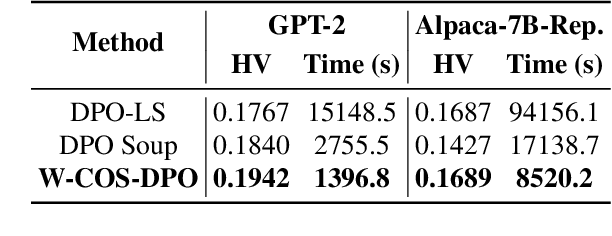
Abstract:In LLM alignment and many other ML applications, one often faces the Multi-Objective Fine-Tuning (MOFT) problem, i.e. fine-tuning an existing model with datasets labeled w.r.t. different objectives simultaneously. To address the challenge, we propose the HyperDPO framework, a hypernetwork-based approach that extends the Direct Preference Optimization (DPO) technique, originally developed for efficient LLM alignment with preference data, to accommodate the MOFT settings. By substituting the Bradley-Terry-Luce model in DPO with the Plackett-Luce model, our framework is capable of handling a wide range of MOFT tasks that involve listwise ranking datasets. Compared with previous approaches, HyperDPO enjoys an efficient one-shot training process for profiling the Pareto front of auxiliary objectives, and offers flexible post-training control over trade-offs. Additionally, we propose a novel Hyper Prompt Tuning design, that conveys continuous weight across objectives to transformer-based models without altering their architecture. We demonstrate the effectiveness and efficiency of the HyperDPO framework through its applications to various tasks, including Learning-to-Rank (LTR) and LLM alignment, highlighting its viability for large-scale ML deployments.
A Sinkhorn-type Algorithm for Constrained Optimal Transport
Mar 08, 2024
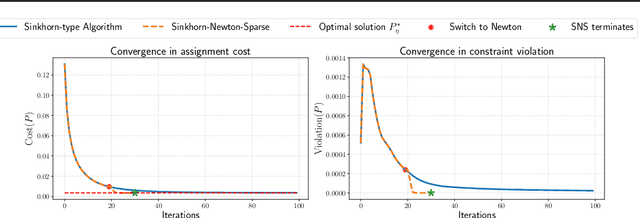

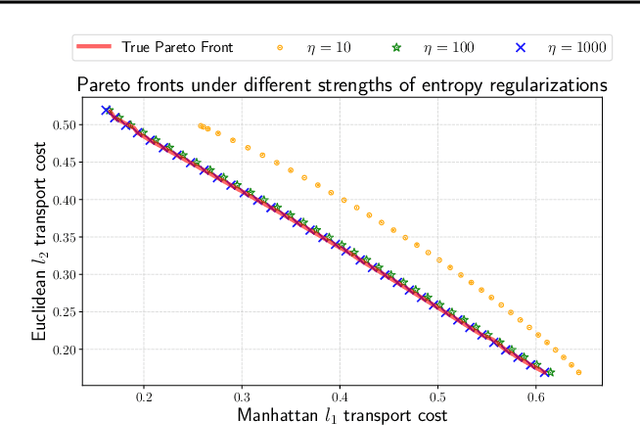
Abstract:Entropic optimal transport (OT) and the Sinkhorn algorithm have made it practical for machine learning practitioners to perform the fundamental task of calculating transport distance between statistical distributions. In this work, we focus on a general class of OT problems under a combination of equality and inequality constraints. We derive the corresponding entropy regularization formulation and introduce a Sinkhorn-type algorithm for such constrained OT problems supported by theoretical guarantees. We first bound the approximation error when solving the problem through entropic regularization, which reduces exponentially with the increase of the regularization parameter. Furthermore, we prove a sublinear first-order convergence rate of the proposed Sinkhorn-type algorithm in the dual space by characterizing the optimization procedure with a Lyapunov function. To achieve fast and higher-order convergence under weak entropy regularization, we augment the Sinkhorn-type algorithm with dynamic regularization scheduling and second-order acceleration. Overall, this work systematically combines recent theoretical and numerical advances in entropic optimal transport with the constrained case, allowing practitioners to derive approximate transport plans in complex scenarios.
Accelerating Sinkhorn Algorithm with Sparse Newton Iterations
Jan 20, 2024Abstract:Computing the optimal transport distance between statistical distributions is a fundamental task in machine learning. One remarkable recent advancement is entropic regularization and the Sinkhorn algorithm, which utilizes only matrix scaling and guarantees an approximated solution with near-linear runtime. Despite the success of the Sinkhorn algorithm, its runtime may still be slow due to the potentially large number of iterations needed for convergence. To achieve possibly super-exponential convergence, we present Sinkhorn-Newton-Sparse (SNS), an extension to the Sinkhorn algorithm, by introducing early stopping for the matrix scaling steps and a second stage featuring a Newton-type subroutine. Adopting the variational viewpoint that the Sinkhorn algorithm maximizes a concave Lyapunov potential, we offer the insight that the Hessian matrix of the potential function is approximately sparse. Sparsification of the Hessian results in a fast $O(n^2)$ per-iteration complexity, the same as the Sinkhorn algorithm. In terms of total iteration count, we observe that the SNS algorithm converges orders of magnitude faster across a wide range of practical cases, including optimal transportation between empirical distributions and calculating the Wasserstein $W_1, W_2$ distance of discretized densities. The empirical performance is corroborated by a rigorous bound on the approximate sparsity of the Hessian matrix.
Pretrained deep models outperform GBDTs in Learning-To-Rank under label scarcity
Jul 31, 2023



Abstract:While deep learning (DL) models are state-of-the-art in text and image domains, they have not yet consistently outperformed Gradient Boosted Decision Trees (GBDTs) on tabular Learning-To-Rank (LTR) problems. Most of the recent performance gains attained by DL models in text and image tasks have used unsupervised pretraining, which exploits orders of magnitude more unlabeled data than labeled data. To the best of our knowledge, unsupervised pretraining has not been applied to the LTR problem, which often produces vast amounts of unlabeled data. In this work, we study whether unsupervised pretraining can improve LTR performance over GBDTs and other non-pretrained models. Using simple design choices--including SimCLR-Rank, our ranking-specific modification of SimCLR (an unsupervised pretraining method for images)--we produce pretrained deep learning models that soundly outperform GBDTs (and other non-pretrained models) in the case where labeled data is vastly outnumbered by unlabeled data. We also show that pretrained models also often achieve significantly better robustness than non-pretrained models (GBDTs or DL models) in ranking outlier data.
 Add to Chrome
Add to Chrome Add to Firefox
Add to Firefox Add to Edge
Add to Edge